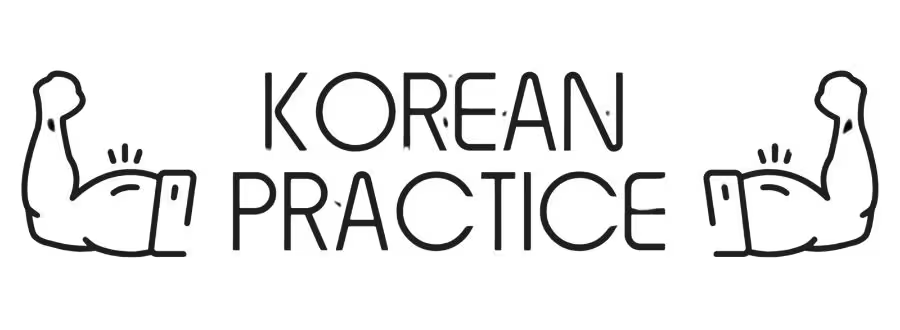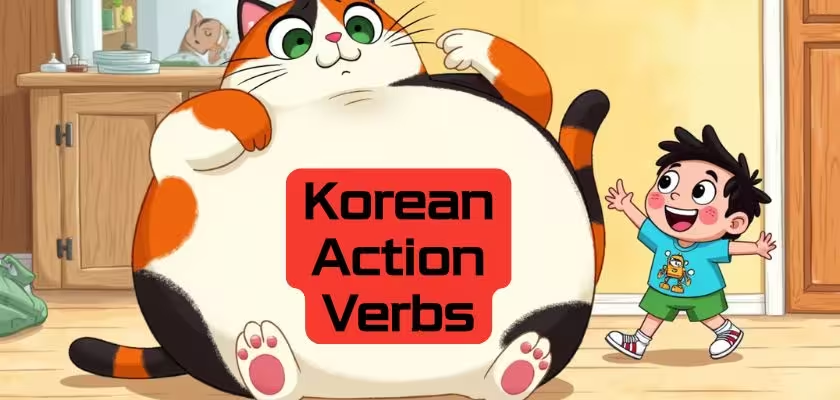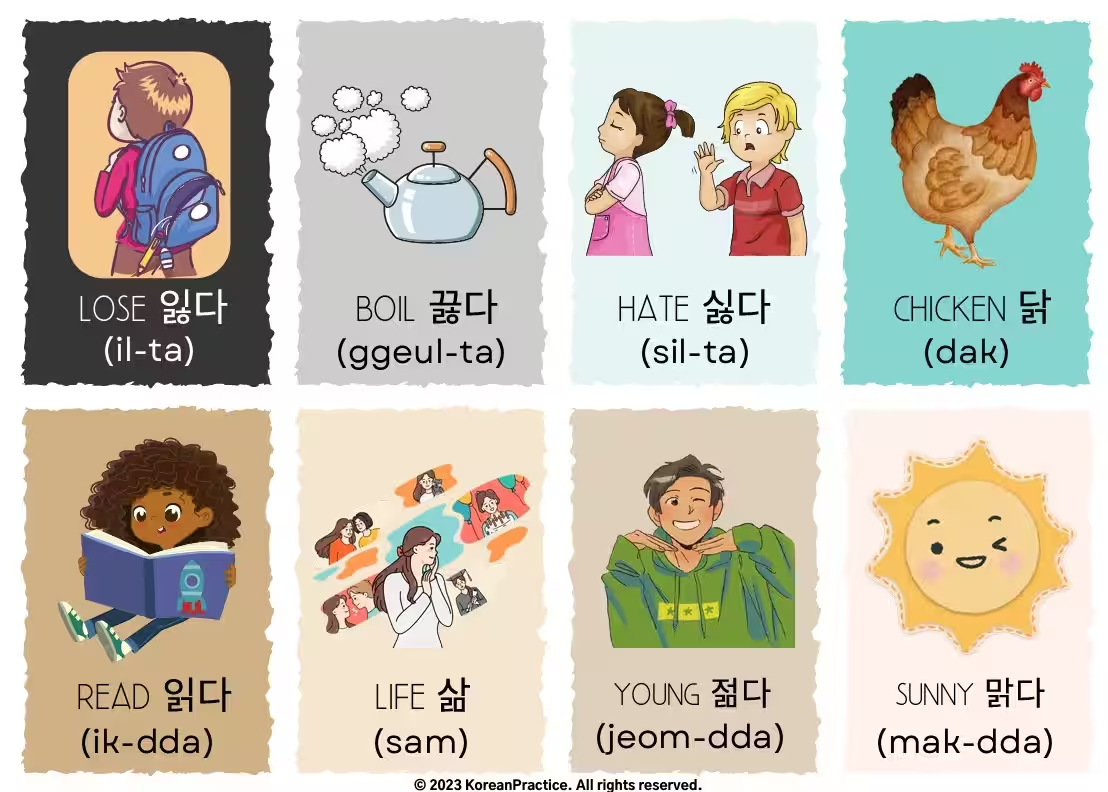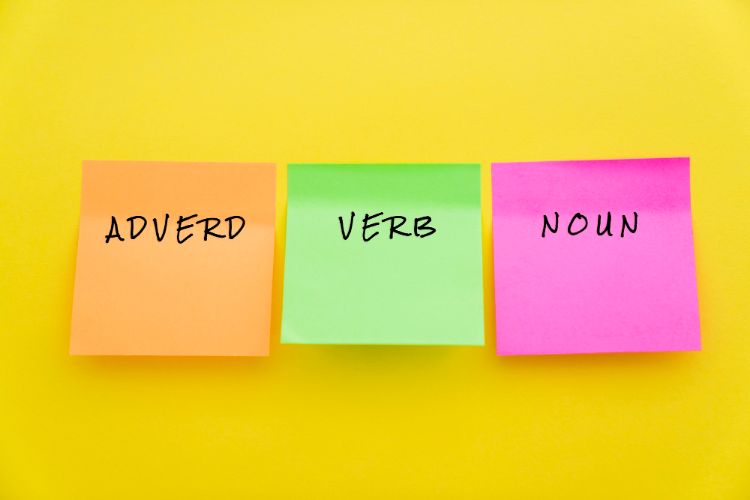Suh ChangWhoon
Written by 서 창훈, a certified Korean teacher with 14+ years of experience in Japan. He previously worked as a government officer, cybersecurity consultant, and English interpreter. Today, he teaches Korean in real classrooms without complex grammar explanations — instead, he trains students’ brains to speak naturally. His unique method is now the foundation of all his Korean courses.
Table of Contents
Why This Korean Animal Story Is Perfect for Intermediate Learners
Many learners get stuck between beginner and intermediate Korean. They know basic action verbs like 가다 (to go), 먹다 (to eat), or 자다 (to sleep), but when they face real-life Korean, they struggle with more specific verbs.
That’s why this Korean animal story about a fat cat is so helpful. It’s full of intermediate Korean action verbs like 굴러떨어지다 (to roll and fall), 튀어나오다 (to pop out), 당기다 (to pull), and 끼다 (to get stuck). These are not random vocabulary words — they’re the kind of precise verbs that make your Korean sound natural and expressive.
This isn’t just simple Korean verb practice. It’s a fun way to improve your Korean reading comprehension while learning the exact verbs Korean speakers really use in daily life.
Watch the Fat Cat in Action
Start the Free Course
Still wondering how to read Korean?

This isn’t just another beginner lesson. It’s a complete system designed to change the way you think about Korean — from struggling with letters to reading real sentences, understanding the language, and speaking out loud with confidence.
In this story, you’ll follow a clumsy, overweight cat who keeps getting into funny situations. He 굴러떨어지다 (rolls and falls) down the stairs, 튀어나오다 (pops out) from tiny spaces, and sometimes 끼다 (gets stuck) in a doorway.
Why is this great for intermediate Korean verb practice? Because you’re not just learning “the cat moves” (고양이가 움직여요). You’re learning how he moves — rolling, popping out, squeezing through, getting wedged. Each verb gives a clear and vivid picture.
Story Style Breakdown™ (Example Sentence)
Let’s break down the first sentence using our Story Style Breakdown™ so you can really understand it:
Original Korean Sentence
뽀로로가 빨리 달려갔어요.
Pronunciation Guide
뽀로로가 (ppo-ro-ro-ga) 빨리 (ppal-li) 달려갔어요 (dal-lyeo-ga-sseo-yo).
Meaning and Context
뽀로로 (Pororo) 가 (subject marker) 빨리 (quickly) 달려갔어요 (ran and went to).
English Translation
Pororo ran quickly.
Literal Translation
Pororo ran and went (to it) quickly.
Original Korean Sentence
뽀로로는 바닥에 굴러떨어졌어요.
Pronunciation Guide
뽀로로는 (ppo-ro-ro-neun) 바닥에 (ba-da-ge) 굴러떨어졌어요 (gul-leo-tteo-reo-jyeo-sseo-yo).
Meaning and Context
뽀로로 (Pororo) 는 (topic marker) 바닥 (floor) 에 (on) 굴러떨어졌어요 (rolled down and fell).
English Translation
Pororo rolled and fell on the floor.
Literal Translation
Pororo rolled and fell on floor.
💡 This is just a simple sample of the Story Style Breakdown™. In my full course, each sentence comes with even more details, variations, and deeper explanations to help you truly understand and use Korean naturally.
Why Korean Animal Stories Work Better Than Textbooks
✅ 1. Visual context makes complex verbs easy
When you see the cat 튀어나오다 (pop out), the meaning is instantly clear without long explanations.
✅ 2. Natural verb combinations
Stories show you how verbs pair with particles and endings. You see compound verbs like 비집고나오다 (to squeeze out) in real sentences.
✅ 3. Emotional connection helps memory
You’ll laugh when the cat waddles (뒤뚱거리다) and feel worried when he gets stuck. That emotion makes the verbs easier to remember.
✅ 4. Smooth difficulty progression
Good Korean animal stories start with easy actions and slowly introduce more complex verbs naturally.
Start the Story Course
Looking for super easy way to learn Korean?
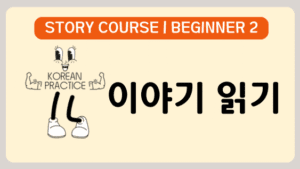
Most Korean courses stop at grammar. Mine goes beyond — with stories, Story Style Breakdown™, and real practice to help you speak.
Advanced Korean Action Verbs You’ll Learn
This story focuses on verbs beyond the beginner level. You’ll practice:
- Complex movement verbs: 굴러떨어지다 (roll and fall), 튀어나오다 (pop out)
- Precise action verbs: 당기다 (pull), 끼다 (get stuck), 빠지다 (slip out)
- Expressive verbs: 야옹야옹 울다 (meow loudly)
These are exactly the verbs intermediate learners need to sound more fluent and natural.
From Basic to Intermediate Korean Reading Comprehension
Beginner textbooks say: 고양이가 떨어져요 (The cat falls).
But intermediate Korean action verbs give richer meaning: 고양이가 굴러떨어져요 (The cat rolls and falls).
See the difference? It feels more alive, like real storytelling. With this approach, Korean reading comprehension becomes easier because:
- You learn precise verbs with real context
- You see how native speakers combine actions naturally
- You understand without heavy grammar explanations
How to Use This Story for Verb Practice
Here’s how to get the most out of this Korean animal story:
Watch for details
Don’t just see “the cat moves.” Notice how it moves — rolling, squeezing, staggering.
Listen for compound verbs
Catch verbs like 굴러떨어지다 that combine two actions into one.
Repeat and describe
Try saying the same sentences yourself. Precision matters.
Compare with basic verbs
Think, “What would a beginner say? What’s the more advanced way?”
Use in new situations
Can you describe other animals or people using the same verbs?
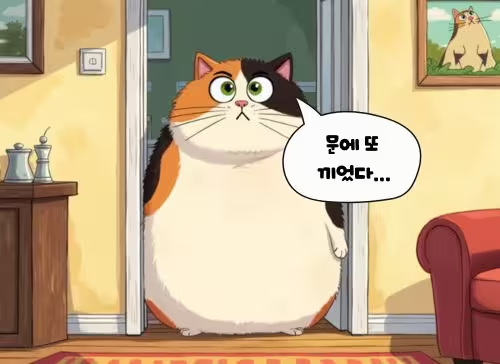
From My Original Story Style Breakdown™ — A New Way to Truly Understand Korean
This is just one sentence from a complete learning system you won’t find anywhere else. — designed to help you understand Korean naturally, without getting lost in grammar rules.
When you can truly understand Korean sentences this way, speaking becomes much easier.
🚀 Quick Learning
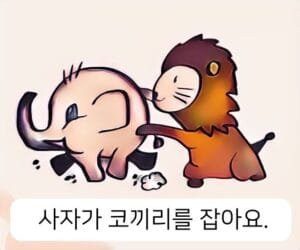
Original Korean Sentence
사자가 코끼리를 잡아요.
Pronunciation Guide
사자가 (sa-ja-ga) 코끼리를 (ko-ggi-ri-reul) 자바요 (ja-ba-yo).
English Translation
The lion catches the elephant.
Literal Translation
Lion catch elephant.
Quick Reference
사자가 (lion) 코끼리를 (elephant) 잡아요 (catch).
💡 Need more details? Click “Deep Learning” below!
🔍 Deep Learning
Meaning and Context
사자 (lion)
→ The lion — the one taking action now in the story.
가 (subject marker)
→ Points out that the lion is doing the action.
코끼리 (elephant)
→ The one the action is done to.
를 (object marker)
→ Shows that the elephant is the object being caught.
잡 (to catch, grab, take)
→ The action — the lion catches or grabs the elephant.
아요 (polite ending)
→ I’m telling you this in a polite and friendly way.
Real-Life Usage
잡아요 is common when talking about catching or holding something.
Pattern Practice
1. 사자가 토끼를 잡아요.
2. 고양이가 쥐를 잡아요.
3. 아이가 공을 잡아요.
4. 강아지가 공을 잡았어요.
Free Korean Flashcard
FAQs (What You Might Still Wonder About)
1. ❓ Can Korean animal stories also help with speaking, not just reading comprehension?
Yes! When you read or watch Korean animal stories, you naturally repeat the same Korean action verbs you saw in context. By describing the animal’s movements out loud, you practice speaking with more precise verbs instead of basic ones.
2. ❓ Do I need to know a lot of grammar before trying Korean verb practice like this?
Not really. Korean reading comprehension improves even if your grammar isn’t perfect, because the story context makes each verb clear. You can pick up how verbs work in natural sentences without heavy grammar study.
3. ❓ Are these intermediate Korean action verbs useful in daily conversations?
Absolutely! Many verbs from Korean animal stories, like 끼다 (to get stuck) or 빠지다 (to slip out), are common in everyday life. Learning them helps you describe situations more naturally with friends or coworkers.
4. ❓ How can I remember so many new Korean action verbs without forgetting them?
Connect each verb to a funny or emotional scene in the story. For example, you’ll never forget 굴러떨어지다 after seeing a cat roll down the stairs. This kind of Korean verb practice sticks in your memory better than flashcards.
5. ❓ Can I use Korean animal stories for self-study, or do I need a teacher?
You can definitely use them for self-study. With clear context, simple translations, and audio, Korean reading comprehension grows naturally. A teacher can guide you further, but these stories are designed to work even if you’re learning alone.
6. ❓ Are there other Korean animal stories that focus on different verbs?
Yes! Each story highlights different types of verbs. For example, a bird story might focus on flying and jumping verbs, while a puppy story could teach playful movement verbs. Exploring more Korean animal stories expands your Korean action verbs step by step.
Final words
Learning intermediate Korean action verbs doesn’t have to feel like memorizing a list. Through Korean animal stories, you connect verbs to real movements, emotions, and funny moments.
This fat cat story helps you:
- Build natural Korean reading comprehension
- Master precise action verbs that textbooks skip
- Feel the difference between basic and intermediate expressions
So watch the cat’s silly adventures and let these Korean action verbs bring your Korean to the next level.
